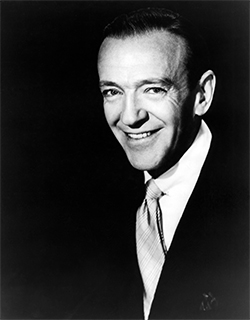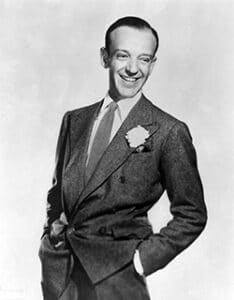 Fred Astaire, born Frederick Austerlitz II in 1899, began show business at the age of four, performing on Broadway and in Vaudeville with his older sister, Adele. As a young adult, he headed to Hollywood where he began a successful partnership with Ginger Rogers for nine movies. He appeared in films with esteemed co-stars such as Joan Crawford, Rita Hayworth, Ann Miller, Debbie Reynolds, Judy Garland, and Cyd Charisse. He also co-starred with the biggest actors of that time, including Bing Crosby, Red Skelton, George Burns, and Gene Kelly. Fred Astaire was not only a great dancer – changing the face of the American movie musical with his style and grace – but he was also a singer, and an actor with many different dramatic and comedic credits, in both movies and TV specials. Fred Astaire also changed the way dance sequences in movies were filmed, insisting that the focus be kept on the full-frame dancers and the dance steps themselves, using a stationary camera shot – with long takes, wide shots & as few cuts as possible, allowing audiences to feel as though they were watching a dancer on stage, versus the then-popular technique of using a constantly roving camera with frequent cuts and close-ups.
Fred Astaire, born Frederick Austerlitz II in 1899, began show business at the age of four, performing on Broadway and in Vaudeville with his older sister, Adele. As a young adult, he headed to Hollywood where he began a successful partnership with Ginger Rogers for nine movies. He appeared in films with esteemed co-stars such as Joan Crawford, Rita Hayworth, Ann Miller, Debbie Reynolds, Judy Garland, and Cyd Charisse. He also co-starred with the biggest actors of that time, including Bing Crosby, Red Skelton, George Burns, and Gene Kelly. Fred Astaire was not only a great dancer – changing the face of the American movie musical with his style and grace – but he was also a singer, and an actor with many different dramatic and comedic credits, in both movies and TV specials. Fred Astaire also changed the way dance sequences in movies were filmed, insisting that the focus be kept on the full-frame dancers and the dance steps themselves, using a stationary camera shot – with long takes, wide shots & as few cuts as possible, allowing audiences to feel as though they were watching a dancer on stage, versus the then-popular technique of using a constantly roving camera with frequent cuts and close-ups.
 Astaire received an honorary Academy Award in 1950 for his “unique artistry and his contributions to the technique of musical pictures.” He holds choreography credits for ten of his movie musicals released between 1934-1961, including “Top Hat”, “Funny Face”, and “The Pleasure of His Company”. He won five Emmys for his work in television, including three for his variety shows, An Evening with Fred Astaire (1959, which won an unprecedented nine Emmys in all!) and Another Evening with Fred Astaire (1960).
Astaire received an honorary Academy Award in 1950 for his “unique artistry and his contributions to the technique of musical pictures.” He holds choreography credits for ten of his movie musicals released between 1934-1961, including “Top Hat”, “Funny Face”, and “The Pleasure of His Company”. He won five Emmys for his work in television, including three for his variety shows, An Evening with Fred Astaire (1959, which won an unprecedented nine Emmys in all!) and Another Evening with Fred Astaire (1960).
In his later years, he continued to appear in movies, including “Finian’s Rainbow” (1968), and “The Towering Inferno” (1974) which earned him an Oscar nomination. He also starred in television roles on programs such as It Takes a Thief, and Battlestar Galactica (which he said he agreed to, due to the influence of his grandchildren). Astaire also lent his voice to several animated children’s TV specials, most notably, Santa Claus Is Comin’ to Town (1970), and The Easter Bunny is Comin’ to Town (1977). Astaire received a Lifetime Achievement Award in 1981 from the American Film Institute, who in 2011, also named him the “Fifth Greatest Actor” (among their “The 50 Greatest Screen Legends” list).

Fred Astaire’s Dance Partners
Although most famous for his magical partnership with Ginger Rogers, Fred Astaire was truly the king of movie musicals, with a film career that spanned 35 years! Astaire paired with dozens of the most famous dancers and movie stars of his time, including:
| Gracie Allen (1895 – 1964) | Adele Astaire (1896 – 1981) |
| Lucille Bremer (1917 – 1996) | Jack Buchanan (1891 -1957) |
| George Burns (1896 – 1996) | Leslie Caron (1931) |
| Joan Caulfield (1922 – 1991) | Cyd Charisse (1922 – 2008) |
| Barrie Chase (1933) | Petula Clark (1932) |
| Joan Crawford (1904 – 1977) | Bing Crosby (1903 – 1977) |
| Virginia Dale (1917 – 1994) | LeRoy Daniels (1928 – 1993) |
| Vera-Ellen (1921 – 1981) | Nanette Fabray (1920 – 2018) |
| Joan Fontaine (1917 – 2013) | Judy Garland (1922 – 1969) |
| Paulette Goddard (1910 – 1990) | Rita Hayworth (1918 – 1987) |
| Audrey Hepburn (1929 – 1993) | Harriet Hoctor (1905 – 1977) |
| Betty Hutton (1921 – 2007) | Olga San Juan (1927 – 2009) |
| Gene Kelly (1912 – 1996) | Claire Luce (1903 – 1989) |
| Ann Miller (1923 – 2004) | George Murphy (1902 – 1992) |
| Janis Paige (1922) | Hermes Pan (1909 – 1990) |
| Eleanor Powell (1912 – 1982) | Jane Powell (1929 ) |
| Marjorie Reynolds (1917 – 1997) | Ginger Rogers (1911 – 1995) |
| Kay Thompson (1909 – 1998) |
“For ballroom dancing, remember that your partners have their own distinctive styles also. Cultivate flexibility. Be able to adapt your style to that of your partner. In doing so, you are not surrendering your individuality, but blending it with that of your partner.
– Fred Astaire, from The Fred Astaire Top Hat Dance Album (1936)
Fred Astaire Films & TV Specials
During his career, Fred Astaire starred in 12 stage performances, 8 dramatic films, 16 television programs, and 33 musical films, including:
Songs Introduced By Fred Astaire
Fred Astaire introduced many songs by famous American composers that became classics, including:
- Cole Porter’s “Night and Day” from The Gay Divorcee (1932)
- Jerome Kern’s “Nice Work If You Can Get It” from A Damsel In Distress (1937) and “A Fine Romance,” “The Way You Look Tonight,” and “Never Gonna Dance” from Swing Time (1936)
- Irving Berlin’s “Cheek To Cheek” and “Isn’t This A Lovely Day” from Top Hat (1936) and “Let’s Face The Music And Dance” from Follow The Fleet (1936)
- Gershwins’ “A Foggy Day” from A Damsel In Distress (1937) and “Let’s Call The Whole Thing Off,” “They All Laughed,” “They Can’t Take That Away From Me,” and “Shall We Dance” from Shall We Dance (1937)
Famous Artists, on Fred Astaire
Even among his peers, Fred Astaire stood alone. Click here to read quotes from famous dancers and actors on Fred Astaire, his skills, and the influence he had on them.
